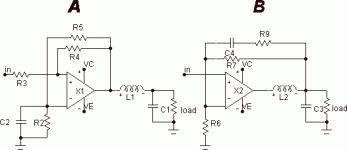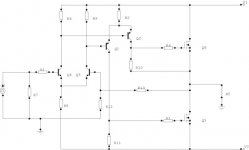You need to convert your audio into pulse width modulation (PWM). Any means of accomplishing this task in real time should work equally well. An old motor control IC, the UC3637 is a pretty easy method.
http://music.dartmouth.edu/~andrew/electronics/amp.html
If you are handy with programming the small microcomputers with built in PWM that is another approach. If you only want a Class D for low frequencies up to 200 Hz, a microcomputer with A/D conversion may be fast enough.
I cannot think of a self oscillating method to convert audio into PWM.
Good Luck
http://music.dartmouth.edu/~andrew/electronics/amp.html
If you are handy with programming the small microcomputers with built in PWM that is another approach. If you only want a Class D for low frequencies up to 200 Hz, a microcomputer with A/D conversion may be fast enough.
I cannot think of a self oscillating method to convert audio into PWM.
Good Luck
Lumanauw could be talking about a circut using a hysteretic buck regulator. These were commonly used in the 80's before switcher ICs became inexpensive, often built around a chip like the UA723 which really wasn't designed to work as a switching regulator. However, if you chose a chip from the right manufacturer, it worked pretty well from an 80's point of view, when bipolar transistors were king, switching frequencies were 25kHz, and 75% efficiency was pretty good. The circuits usually depended on a parasitic element like capacitor ESR to get a signal to switch on , and so they could be inconsistent in operation. A modern approach to a switching buck regulator would be to sense the current flowing between the main filter inductor and the load using a small value resistor, amplifying this signal with a good quality op amp, and feeding it to a hysteretic comparator to generate the PWM signal. The ramp is provided by the inductor current. The advantage of a hysteretic regulator is that it will stay on until the inductor current reaches the value programmed by the hysteretic comparator, hence it has a faster slew rate than a conventional fixed frequency PWM approach. Having said that, I would still only use it in an application where I needed gobs of power with a limited bandwidth, like a subwoofer amp.
You refreshed my poor memory. I remember such chaotic switching power supplies. I was trying to make a linear voltage regulator with a precision reference, opamp (LM158 I think) and a series pass transistor and it had an oscillation problem, so I through in an output inductor and changed the opamp to a voltage comparator (LM139 I think). I did have to add a little positive feedback for the hysteresis (resistor from output of transistor to positive input of comparator), but it worked great and was much more efficient. Frequency varied a little with load, but mostly with input line voltage. That was in 1981 or 82.
I'm not sure how to modulate with the audio, but I bet you can do it. Like you mentioned, only use for low frequency amp, because of the variable frequency operation.
I'm not sure how to modulate with the audio, but I bet you can do it. Like you mentioned, only use for low frequency amp, because of the variable frequency operation.
Hi,
basically you have two types of self oscillating class D designs, one that takes feedback from the switching stage and one that takes feedback from output filter. The first type is the most common, and you can see more at Sorensen Audioexperiment . Regarding second approach search this forum for UCD amplifier.
Best regards,
Jaka Racman
basically you have two types of self oscillating class D designs, one that takes feedback from the switching stage and one that takes feedback from output filter. The first type is the most common, and you can see more at Sorensen Audioexperiment . Regarding second approach search this forum for UCD amplifier.
Best regards,
Jaka Racman
hi all,
This two circuits almost identical to other circuits which can be found in any textbook, however they famous today as class D self oscillation amps (A- similar to typical opamp square wave gen, B- to conventional linear power amp, just with enlarged coil value, and added phase lead term for switching freq. control).
This two circuits almost identical to other circuits which can be found in any textbook, however they famous today as class D self oscillation amps (A- similar to typical opamp square wave gen, B- to conventional linear power amp, just with enlarged coil value, and added phase lead term for switching freq. control).
Attachments
Hey, thats it! This maybe one answer.
With my 3 basic understanding, maybe we can make a self oscilating class D
1. Output mosfets in class D is only working on-off, with modulated width (PWM), its width is proportional to the analog signal. It forms PWM square wave.
2. Opamps are linear amplifier. It can swing to any analog voltage within its VCC range. The pins are non inverting (+), inverting (-) and output.
3. Comparator is a saturated amplifier. Its output is only up or down, without any voltage between the VCC. Has the same 3 pins like opamp.
Maybe someone with simulator can help me. Imagine we built a simple inverting preamp, gain=-10x, using opamp, like TL071. The VCC will be +/-5Vdc. The non inverting input (+) is grounded. The input is taken to inverting input via 1k resistor. The feedback is taken to (-) input via 10k resistor. This will be magnifying audio signal to -10x, right?
Now we replace the TL071 with comparator, like LM311. And we put LC filter to its output. The feedback is taken after the LC filter. The comparator itself will be working in square wave, but after LC wouldn't it be analog?
Is this a self oscilating class D? Making saturating ordinary class AB amp, but putting LC filter in its output?
With my 3 basic understanding, maybe we can make a self oscilating class D
1. Output mosfets in class D is only working on-off, with modulated width (PWM), its width is proportional to the analog signal. It forms PWM square wave.
2. Opamps are linear amplifier. It can swing to any analog voltage within its VCC range. The pins are non inverting (+), inverting (-) and output.
3. Comparator is a saturated amplifier. Its output is only up or down, without any voltage between the VCC. Has the same 3 pins like opamp.
Maybe someone with simulator can help me. Imagine we built a simple inverting preamp, gain=-10x, using opamp, like TL071. The VCC will be +/-5Vdc. The non inverting input (+) is grounded. The input is taken to inverting input via 1k resistor. The feedback is taken to (-) input via 10k resistor. This will be magnifying audio signal to -10x, right?
Now we replace the TL071 with comparator, like LM311. And we put LC filter to its output. The feedback is taken after the LC filter. The comparator itself will be working in square wave, but after LC wouldn't it be analog?
Is this a self oscilating class D? Making saturating ordinary class AB amp, but putting LC filter in its output?
Hello. Yes, what you describe is like picture B above. That diagram shows how it is done. For more ideas on how a simulated circuit was built see the circuit on this Web page . It may give some insight on how it is possible to do.
I've done some search about UCD amp. It turns out that the patent is EXACTLY the drawing B (IVX's).
If my previous idea is using a saturated amp (more like comparator than opamp), then, after looking at this drawing B (UCD patent), I think this principle can be done with any class AB amp, without having to change it to saturated amp.
Why? Because the inductor in LC filter itself will make the output transistors in ordinary class AB amp works to saturated amp (producing square waves), to make analog output after LC. Is this right?
If my previous idea is using a saturated amp (more like comparator than opamp), then, after looking at this drawing B (UCD patent), I think this principle can be done with any class AB amp, without having to change it to saturated amp.
Why? Because the inductor in LC filter itself will make the output transistors in ordinary class AB amp works to saturated amp (producing square waves), to make analog output after LC. Is this right?
Most linear AB amps won't like working continuously in saturated mode very much - they may even overheat and blow up, depending on the outout drivers that are used. Most linear amps take their own sweet time coming out of clipping because of storage time effects in the driver (and output, if bipolar) transistors. You really want to build an amp optimized for switching operation.
Hi lumanauw,
why you want to force class AB (why need bias) for working as class D? ( a cow could be flying?) For any of class D experimentation simplest solution is a power comparator (lm319+ir2110 etc). If you'll be have such power comparator, then one week be enough for checking several basic class D circuits. But anyway UcD is most cost effective approach, IMHO. Sound & specs just fine.
why you want to force class AB (why need bias) for working as class D? ( a cow could be flying?) For any of class D experimentation simplest solution is a power comparator (lm319+ir2110 etc). If you'll be have such power comparator, then one week be enough for checking several basic class D circuits. But anyway UcD is most cost effective approach, IMHO. Sound & specs just fine.
BTW, that is not my design. I found it here in DIYAUDIO.
Anyone can explain why we need R2, Q1, Q2 in that configuration? Wouldn't it formed a differential? Why the author do not connect emitors of Q1 and Q2 directly to upper rail? Why he forms a differential? What is the merit of this configuration in this particular cct?
Anyone can explain why we need R2, Q1, Q2 in that configuration? Wouldn't it formed a differential? Why the author do not connect emitors of Q1 and Q2 directly to upper rail? Why he forms a differential? What is the merit of this configuration in this particular cct?
One reason for R2 is to prevent those transistors from going into saturation which would make their response very nonlinear, and cause lots of distortion. It also would help to smooth the crossover between mosfets. But when I experimented with that circuit years ago, it was quite distorted. Also, that type of mosfet drive definitely is way too slow for class D.
- Status
- This old topic is closed. If you want to reopen this topic, contact a moderator using the "Report Post" button.
- Home
- Amplifiers
- Class D
- Looking for self oscilating class D

